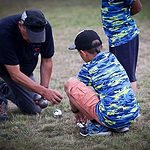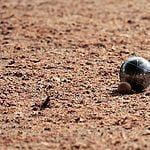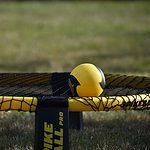If you've ever wondered about the dimensions of a cornhole board, you're not alone. Understanding the size of a cornhole board is crucial for both recreational players and those aiming for competitive play.
However, the dimensions of these boards go beyond just length and width. Exploring the reasons behind the different sizes available can shed light on why one might be more suitable for your cornhole needs.
Let's uncover the details that might influence your decision when selecting a cornhole board size.
Key Takeaways
- Regulation size boards are 4 feet by 2 feet, while tailgate boards are 3 feet by 2 feet.
- Regulation boards offer stability, tailgate boards are more portable for outdoor activities.
- Cornhole board measurements include a 6-inch hole diameter and a 3-inch front edge height.
- Board size impacts gameplay tactics, shot accuracy, and transportability.
Standard Cornhole Board Dimensions
Standard cornhole boards typically measure 2 feet by 4 feet in size, providing a playing surface of 23 1/2' x 47 1/2'. This standardized size ensures consistency in gameplay and competition.
The front edge of the board is set at a height of 3 inches from the ground, allowing for the proper angle and trajectory of the bags when thrown. The hole in the board, which is a crucial element of the game, has a diameter of 6 inches. This dimension is carefully determined to ensure the right level of challenge for players aiming to score points by getting the bags through the hole.
The specific measurements of a cornhole board are essential for creating a fair and enjoyable playing experience. The size of the playing surface, the height of the front edge, and the diameter of the hole are all carefully calculated to maintain the integrity of the game while offering players a standard platform to showcase their skills.
Regulation Size Vs Tailgate Size
When considering cornhole boards, the distinction between regulation size and tailgate size becomes crucial for understanding their respective applications and benefits.
- Regulation Size
- Dimensions: Regulation size cornhole boards measure 4 feet by 2 feet.
- Weight: These boards are heavier, weighing around 30 lbs each.
- Usage: Regulation size boards are standard in professional tournaments due to their size and weight, providing stability during gameplay.
- Durability: Constructed with high-quality materials to withstand frequent use in competitive settings.
- Tailgate Size
- Dimensions: Tailgate size cornhole boards are slightly smaller at 3 feet by 2 feet.
- Weight: These boards are lighter, weighing about 20 lbs each.
- Portability: Tailgate size boards are more portable and easier to transport, making them ideal for outdoor activities like tailgating, picnics, and casual games.
- Space Efficiency: The smaller size of tailgate boards makes them a better fit for smaller outdoor spaces or when storage is limited.
Cornhole Board Size Comparison
Curious about the key differences in size between regulation and tailgate cornhole boards?
Regulation size cornhole boards measure 4 feet by 2 feet, while tailgate size boards are slightly smaller at 3 feet by 2 feet. This variation in size directly impacts the transportability and space requirements of the boards.
Regulation boards, commonly employed in professional tournaments, weigh about 30 lbs each, providing stability during gameplay. On the other hand, tailgate size boards weigh around 20 lbs each, making them more portable and suitable for outdoor activities like tailgating or picnics.
Both regulation and tailgate boards are built using quality materials to ensure durability, with regulation boards designed for a more competitive playing experience. Understanding the size differences between these two types of cornhole boards allows you to choose the most suitable option based on your preferences and intended use.
Understanding Cornhole Board Measurements
To understand the precise measurements of a cornhole board, it's essential to grasp the specific dimensions that govern its construction and gameplay.
Regulation cornhole boards adhere to specific dimensions to ensure a fair and consistent game. Here are the key measurements you need to know:
- Size: Regulation cornhole boards measure 4 feet by 2 feet, providing ample space for gameplay.
- Hole Diameter: The 6-inch diameter hole is strategically placed at the center of the board to challenge players.
- Board Height: The front of the board stands at 3 inches high, while the back rises to 12 inches, creating the characteristic slope.
- Hole Placement: The hole is centered 8 7/8 inches from the top and 12 inches from each side, adding precision to the game.
Understanding these measurements ensures that you have the right equipment for a proper cornhole game. The dimensions play a crucial role in maintaining the integrity and challenge of the game.
Ideal Cornhole Board Dimensions
Discussing the ideal dimensions for a cornhole board involves precise measurements to ensure optimal gameplay experience. The regulation size for a cornhole board, as defined by the American Cornhole organization, is 4 feet by 2 feet. This standard size provides consistency across games and tournaments, allowing players to practice and compete on boards with identical dimensions. The cornhole board dimensions play a crucial role in the game, influencing the difficulty and accuracy of shots. Here is a breakdown of the key measurements for a regulation cornhole board:
| Aspect | Measurement |
|---|---|
| Board Size | 4 feet by 2 feet |
| Hole Diameter | 6 inches |
| Front Edge Height | 3 inches |
| Back Edge Height | 12 inches |
| Hole Placement | 8 7/8 inches from the top, 12 inches from each side |
| Leg Angle | 109 degrees |
These dimensions are carefully designed to create a fair and challenging playing field for all participants. The regulation size ensures that players can hone their skills consistently and enjoy a competitive game of cornhole.
Impact of Board Size on Gameplay
The size of a cornhole board directly impacts gameplay tactics and player strategies, influencing the overall experience on the playing field. Understanding the implications of board size can enhance your gameplay.
Consider the following:
- Regulation Size: Regulation size boards, measuring 2 feet by 4 feet, provide a standard playing surface. Their larger surface area allows for more precise shots, challenging players to hone their aim and power control.
- Tailgate Size: Tailgate size boards, typically 2 feet by 3 feet, offer a more compact option. Despite the smaller surface area, players can still execute similar gameplay tactics as on regulation boards, adapting their throws to the reduced target space.
- Surface Area: The surface area of the board directly affects how players approach their throws. A larger board demands more accuracy, while a smaller board may require adjustments in strength and angle to land shots successfully.
- Gameplay Tactics: Players may need to adjust their gameplay tactics based on the board size they're using. Smaller boards can encourage riskier plays, while larger boards promote strategic, calculated moves.
Choosing the Right Cornhole Board Size
When selecting the appropriate cornhole board size, consider the specific dimensions that best suit your playing needs and preferences. Regulation size boards, measuring 4 feet by 2 feet, are the standard for professional tournaments, ensuring consistency in gameplay.
On the other hand, tailgate size boards, at 3 feet by 2 feet, offer a more portable option for outdoor activities such as tailgating or backyard gatherings. The size of the boards not only impacts gameplay but also affects transportability. Regulation size boards typically weigh around 30 lbs each, while tailgate size boards are lighter at approximately 20 lbs each, making them easier to transport.
It's essential to adhere to the specific criteria for both regulation and tailgate size boards to maintain fairness and consistency in the game. By considering factors like regulation size for standard play and tailgate size for portability, you can choose the right cornhole board size that best fits your needs.
Cornhole Board Size Considerations
Considering the various factors impacting cornhole board size, it's crucial to assess your space constraints, portability requirements, and intended usage to make an informed decision. When selecting a cornhole board size, here are some key considerations to keep in mind:
- Regulation Size: Regulation cornhole boards measure 4 feet by 2 feet and are commonly used in professional tournaments to ensure consistent gameplay experience.
- Custom Cornhole: Custom cornhole boards allow for personalized dimensions, catering to individual preferences and needs.
- Smaller Boards: Tailgate cornhole boards are smaller at 3 feet by 2 feet, making them more portable and lightweight, ideal for casual games on the go.
- Cornhole Set: The size of a cornhole board doesn't affect the rules or scoring of the game, but it does impact transportability, with regulation boards weighing around 30 lbs each and tailgate boards weighing around 20 lbs.
Factors Affecting Cornhole Board Dimensions
Exploring the factors influencing cornhole board dimensions can enhance your understanding of the game's equipment requirements and gameplay dynamics. Regulation size cornhole boards, measuring 4 feet by 2 feet, are utilized in professional tournaments to ensure consistent gameplay standards.
In contrast, tailgate size boards, with dimensions of 3 feet by 2 feet, offer a more portable and compact option suitable for outdoor activities like tailgating. The size of the cornhole board directly impacts its transportability, space utilization, and player experience during gameplay.
Regulation size boards, weighing a minimum of 25 lbs, provide stability and durability for competitive play, while tailgate size boards, being lighter at 20 lbs, offer easier portability. Both regulation and tailgate cornhole boards adhere to specific dimensions to ensure fair play and compliance with regulations, contributing to a standardized experience for players across different settings.
Understanding these factors can help you choose the right cornhole board size based on your preferences and intended use.
Common Cornhole Board Size Questions
Have you ever wondered about the dimensions of a standard cornhole board? Here are some common questions regarding cornhole board sizes:
- Regulation Size: A regulation cornhole board is typically 2 feet by 4 feet, with a playing surface measuring 23 1/2' x 47 1/2'. These dimensions ensure that the board complies with official cornhole standards.
- Cornhole Bags: The hole on a cornhole board has a standard diameter of 6 inches. This size is designed to accommodate regulation cornhole bags perfectly.
- Official Cornhole: To meet official cornhole regulations, the front edge height of a cornhole board should be 3 feet from the ground to the playing surface, while the back edge should be 12 feet high. These measurements ensure the proper incline for fair gameplay.
- Make Your Own: If you're looking to make your own cornhole board, following these standard dimensions will help you create a board that aligns with official cornhole guidelines.





